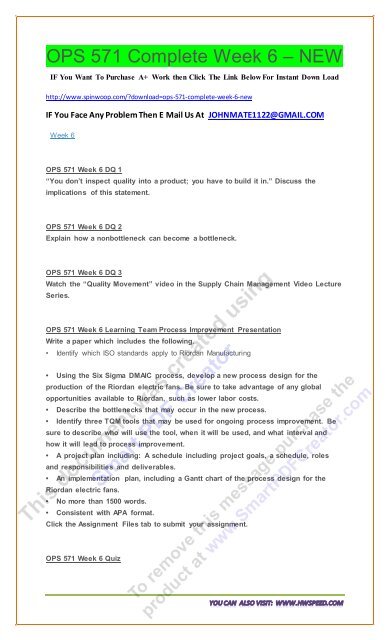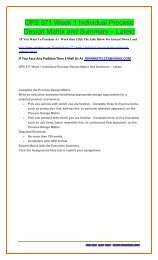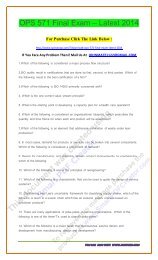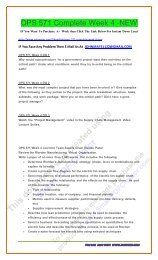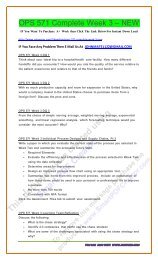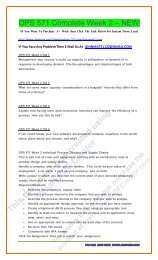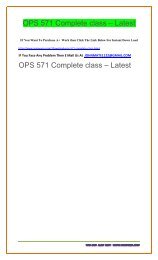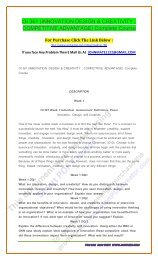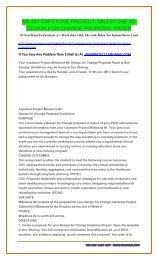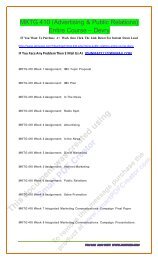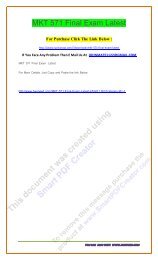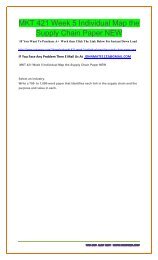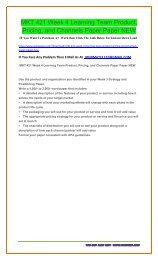OPS 571 Complete Week 6 – NEW
You also want an ePaper? Increase the reach of your titles
YUMPU automatically turns print PDFs into web optimized ePapers that Google loves.
<strong>OPS</strong> <strong>571</strong> <strong>Complete</strong> <strong>Week</strong> 6 <strong>–</strong> <strong>NEW</strong><br />
IF You Want To Purchase A+ Work then Click The Link Below For Instant Down Load<br />
http://www.spinwoop.com/?download=ops-<strong>571</strong>-complete-week-6-new<br />
IF You Face Any Problem Then E Mail Us At JOHNMATE1122@GMAIL.COM<br />
<strong>Week</strong> 6<br />
<strong>OPS</strong> <strong>571</strong> <strong>Week</strong> 6 DQ 1<br />
“You don’t inspect quality into a product; you have to build it in.” Discuss the<br />
implications of this statement.<br />
<strong>OPS</strong> <strong>571</strong> <strong>Week</strong> 6 DQ 2<br />
Explain how a nonbottleneck can become a bottleneck.<br />
<strong>OPS</strong> <strong>571</strong> <strong>Week</strong> 6 DQ 3<br />
Watch the “Quality Movement” video in the Supply Chain Management Video Lecture<br />
Series.<br />
<strong>OPS</strong> <strong>571</strong> <strong>Week</strong> 6 Learning Team Process Improvement Presentation<br />
Write a paper which includes the following.<br />
• Identify which ISO standards apply to Riordan Manufacturing<br />
• Using the Six Sigma DMAIC process, develop a new process design for the<br />
production of the Riordan electric fans. Be sure to take advantage of any global<br />
opportunities available to Riordan, such as lower labor costs.<br />
• Describe the bottlenecks that may occur in the new process.<br />
• Identify three TQM tools that may be used for ongoing process improvement. Be<br />
sure to describe who will use the tool, when it will be used, and what interval and<br />
how it will lead to process improvement.<br />
• A project plan including: A schedule including project goals, a schedule, roles<br />
and responsibilities and deliverables.<br />
• An implementation plan, including a Gantt chart of the process design for the<br />
Riordan electric fans.<br />
• No more than 1500 words.<br />
• Consistent with APA format.<br />
Click the Assignment Files tab to submit your assignment.<br />
<strong>OPS</strong> <strong>571</strong> <strong>Week</strong> 6 Quiz
1.) Which of the following are examples of Goldratt’s Rules of Production<br />
Scheduling?<br />
An hour saved at a bottleneck is a mirage<br />
Nonbottlenecks govern throughput<br />
Utilization and activation are the same<br />
Balance flow, not capacity<br />
2.) According to the theory of constraints which of the following can be a CCR?<br />
Product design<br />
An employee<br />
Factory layout<br />
A customer<br />
3.) The Shingo approach to quality control depends on which of the following?<br />
Use of statistically based approaches to quality control<br />
Use of source inspection on 100% of the items produced<br />
Extensive use of control charts<br />
Use of a sophisticated method of acceptance sampling<br />
4.) Statistical Process Control (SPC) and data from the actual process to statistically<br />
monitor the process over time are employed during which step of the DMAIC cycle?<br />
Define<br />
Control<br />
Improve<br />
Measure<br />
5.) According to the theory of constraints, which of the following is an<br />
OPERATIONAL measurement that can be used to measure the firm’s ability to make<br />
money?<br />
Operating revenue<br />
Unit cost<br />
Inventory<br />
Net Profit<br />
6.) The DMAIC cycle of Six Sigma is similar to which of the following quality<br />
management topics?<br />
External benchmarking<br />
ISO 9000<br />
SERQUAL<br />
Continuous improvement
7.) The Shingo system of quality control relies heavily on fail-safe procedures or<br />
devices called what?<br />
Checklists<br />
DPMO’s<br />
CTQs<br />
Poka-yokes<br />
8.) Identifying critical-to-quality characteristics (CTQs) takes place in which step of<br />
the DMAIC methodology?<br />
Analyze<br />
Define<br />
Improve<br />
Measure<br />
9.) According to the theory of constraints which of the following is a FINANCIAL<br />
measurement that can be used to measure the firm’s ability to make money?<br />
Sales<br />
Cash flow<br />
Inventory<br />
Operating expenses<br />
10.) Goldratt’s theory of constraints (TOC) could be restated using which of the<br />
following?<br />
A system with constraints will not be able to achieve its goals<br />
Any system is limited in achieving more of its goals by a very small number of<br />
constraints<br />
A system constraint cannot be identified and thus cannot be improved<br />
Continuous adjustments after a constraint problem is solved will cause more<br />
problems<br />
11.) The idea that statistical methods of quality control, including six-sigma, does not<br />
prevent defects, is central to what alternative quality system?<br />
SQC methods<br />
Deming PDCA cycle<br />
DMAIC cycle<br />
Shingo System<br />
12.) A bottleneck in a manufacturing process may be targeted and eliminated by<br />
employing which of the following?<br />
Install more efficient equipment where capacity is less than the demand.<br />
Increase labor equally throughout the system.<br />
Increase the capacity of a nonbottleneck resource.
Increase the idle time of a capacity-constrained resource in the system.<br />
13.) Which of the following is a focusing step of Dr. Eli Goldratt’s theory of<br />
constraints?<br />
Do not modify a process after improvement of a constraint is achieved.<br />
Isolate constraints to reduce the constraint’s capacity.<br />
Align the whole system to support processes prior to the constraint.<br />
Identify system constraints that prevent the system from achieving its goal.<br />
14.) According to Goldratt, which of the following is defined as “any resource whose<br />
capacity is less than the demand placed on it”?<br />
Bottleneck resource<br />
Buffer resource<br />
Nonbottleneck resource<br />
Capacity-constrained resource<br />
15.) According to the theory of constraints, which of the following would be included<br />
in the Throughput operational measurement?<br />
Work in process<br />
Finished goods<br />
Goods sold


